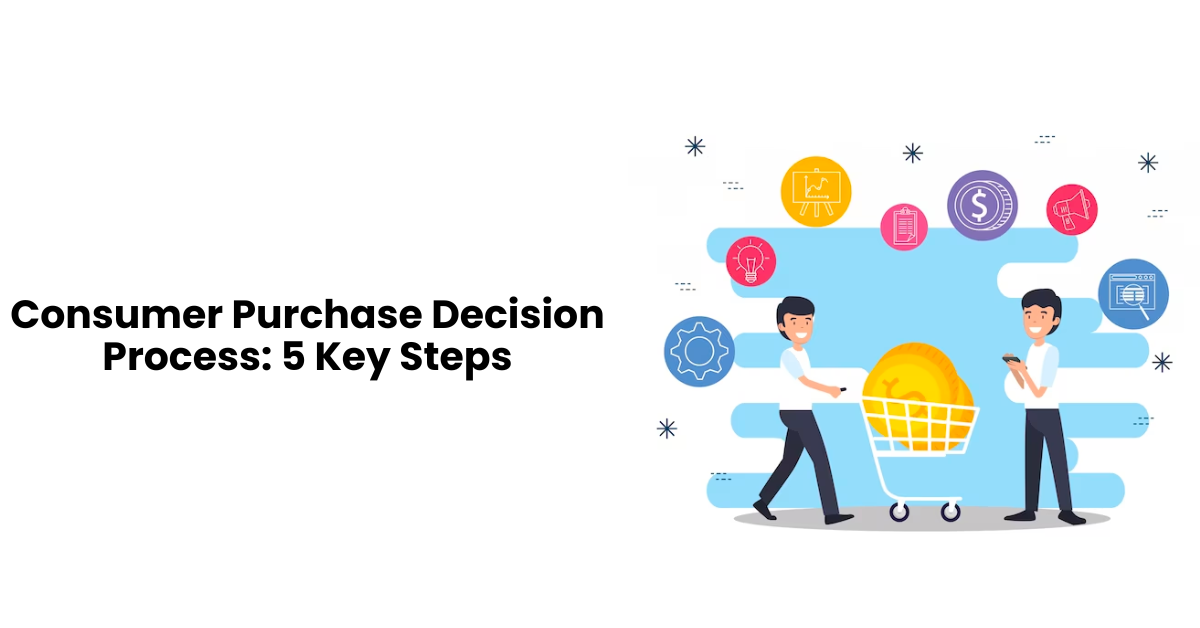The Consumer Purchase Decision Process: 5 Key Steps

The process by which consumers decide to buy a product or service involves a series of steps, each crucial in determining the final purchase. This process, known as the Consumer Purchase Decision Process, is a journey that starts from the moment a need is recognized and culminates in the post-purchase evaluation. In this blog, we'll explore the consumer purchase decision process steps of this process. Understanding these steps is essential for businesses and marketers to effectively align their strategies with consumer behavior and preferences. By delving into each stage, we gain insights into what drives consumer choices and how businesses can influence these decisions to better meet the needs of their customers.
Importance of consumer decision making process
Understanding the consumer decision process is crucial for businesses, as it helps in crafting strategies that align with consumer behavior and preferences. This customer journey, from recognizing a need to post-purchase evaluation, offers key insights into what motivates a consumer's buying decisions. Making a good purchasing decision requires businesses to comprehend each step, allowing them to tailor marketing efforts, product development, and customer service effectively. This approach leads to increased customer satisfaction, loyalty, and ultimately, business success. For instance, customers heavily weighing peer reviews can prompt businesses to focus on building a robust online review presence. Engaging with consumers throughout their decision-making journey can lead to more effective marketing, higher sales, and stronger brand loyalty.
5 steps for consumer purchase decision process
The five steps in the consumer decision making process are:
Recognizing a Need

Recognizing a need is the initial and a crucial step in the Consumer Purchase Decision Process. This stage is where the consumer becomes aware of a gap between their current state and a desired state, sparking the motivation for a purchase. It's often triggered by internal stimuli, like personal needs or desires, or external stimuli, such as advertising or word-of-mouth.
For example, consider a person who has recently taken up running. After a few days, they may start feeling the inadequacy of their regular sneakers for this specific activity. This realization - that their current shoes aren't suitable for running - creates a need for a new pair of running shoes. It's this recognition that propels them into the next stages of the purchase decision process, where they will seek information, evaluate alternatives, make a purchase decision, and reflect on their purchase after buying the shoes.
Thus, the need recognition phase is essential as it sets the course for the consumer's journey towards making a purchase, influencing the type of products they consider and the criteria they use in their decision-making.
Information Search

The 'Information Search' step in the consumer purchase decision process is where consumers actively seek out information to fill a gap in their knowledge. This search can be internal, relying on memory and past experiences, or external, involving seeking information from friends, family, advertising, or online sources.
For example, consider a consumer planning to buy a new smartphone. Initially, they may recall their experiences with past brands or models and discuss with friends. If this internal search is insufficient, they'll turn to external sources like online reviews, expert opinions, and brand websites. They might visit forums, watch video reviews, or read blog posts comparing different smartphones. This phase is crucial as the information gathered significantly influences the consumer's subsequent choices, shaping their perception of available options and guiding them towards a product that best meets their needs and preferences.
Evaluation of Alternatives

The "Evaluation of Alternatives" is a crucial step in the consumer purchase decision process, where consumers weigh different options before making a final choice. After recognizing a need and gathering information, consumers assess various products or services against their criteria and preferences.
For example, consider someone looking to buy a smartphone. They start by identifying key features important to them, like battery life, camera quality, and price. They might compare different brands and models, reading reviews, and seeking recommendations. This evaluation is influenced by factors like personal taste, perceived brand value, and past experiences.
Consumers often rank or prioritize alternatives based on their importance. In our smartphone example, if photography is a passion, camera quality might weigh more heavily in their decision than battery life. This step isn’t just about logical assessment; emotional responses and brand perceptions play a significant role too.
The evaluation stage is where marketing efforts can have a significant impact. Effective advertising, positive reviews, and strong brand positioning can sway consumer preference. Ultimately, this step determines which product the consumer deems the best fit for their needs and leads them closer to the purchase decision.
Making the Purchase Decision

The "Making the Purchase Decision" step is a critical juncture in the Consumer Purchase Decision Process. This is where a consumer finally decides whether to buy a product or service, culminating from the preceding steps of need recognition, information search, and evaluation of alternatives.
For instance, consider a consumer planning to buy a new smartphone. After realizing the need (perhaps an outdated model), researching various brands and models (information search), and comparing features and prices (evaluation of alternatives), the consumer reaches the decision-making stage. Here, factors like brand preference, perceived value, personal budget, and even peer recommendations play a significant role. The consumer weighs these aspects against their personal needs and preferences. Perhaps they find a particular model that strikes a balance between price and the latest features, or they might choose a brand they’ve had a positive experience with in the past.
The decision might also be influenced by promotional offers or financing options. For example, a special discount or a 0% EMI offer could be the final nudge they need to choose one smartphone over another.
Post-Purchase Behavior

Post-Purchase Behavior is a critical stage in the consumer purchase decision process, as it reflects the consumer's reaction after making a purchase. This stage is crucial because it influences repeat purchases, brand loyalty, and word-of-mouth recommendations.
For instance, consider a customer who buys a new smartphone. After the purchase, they evaluate their satisfaction with the product. If the phone meets or exceeds their expectations, they are likely to experience high satisfaction, leading to positive reviews and recommendations to friends and family. This could also foster brand loyalty, making them more inclined to choose the same brand in the future.
Conversely, if the smartphone fails to meet expectations, the customer may experience buyer’s remorse. This could lead to negative reviews, returns, or complaints, and the customer might avoid the brand in the future.
In this phase, businesses can engage with customers through follow-up emails, customer satisfaction surveys, and responsive customer service. Addressing any issues, encouraging feedback, and showing appreciation can enhance customer satisfaction and loyalty, turning one-time buyers into repeat customers and brand advocates.
External Influences on the Decision Process
External influences play a significant role in shaping the consumer purchase decision process. These influences come from various sources and can profoundly impact how consumers perceive needs, gather information, and make final decisions. Key external factors include:
- Social Influences: Family, friends, and social groups often affect consumer choices. Recommendations or opinions from these groups can sway decisions, especially in markets where social approval is important.
- Cultural Factors: A consumer's cultural background dictates their values, beliefs, and customs, influencing their purchasing behavior. Products that align with or respect these cultural norms tend to be more successful.
- Marketing Campaigns: Advertising and promotional efforts by businesses can shape consumer perceptions and preferences, guiding them towards specific products or brands.
- Economic Conditions: The broader economic environment, including factors like consumer purchasing power and economic stability, can influence spending habits and priorities.
- Technological Advancements: The rise of digital media and online shopping platforms has altered how consumers research and buy products.
The Role of Digital Media in the Decision Process
Digital media plays a pivotal role in the buying decision process, profoundly influencing how consumers gather information and make buying decisions. In today’s digital age, consumers often turn to online platforms as their first source of product information. Social media, review sites, blogs, and forums have become crucial for gauging opinions and experiences of other consumers. These platforms offer a wealth of user-generated content that provides insights into product quality, usage, and satisfaction.
Moreover, digital advertising and targeted marketing campaigns can significantly sway consumer preferences and choices. Personalized ads, based on the user’s online behavior and preferences, appear across different digital platforms, guiding the consumer subtly through the purchase process. For many consumers, the ease of accessing information and reviews online, along with the influence of digital marketing, makes digital media an essential element in their decision-making. This underscores the need for businesses to have a robust digital presence and an engaging online strategy to effectively influence and facilitate consumer purchase decisions.
How Manifest AI can influence the consumer purchase decision process?

Manifest AI, through its advanced AI capabilities, can significantly influence the consumer purchase decision process. Here's how it contributes:
- Preventing Drop-offs: Manifest AI proactively identifies when a consumer is about to leave the site and intervenes to prevent this, enhancing customer retention.
- Boosting Purchase Value: It anticipates when a consumer is ready to make a purchase and suggests additional products, increasing the average order value for the brand.
- Assisting in Search: Manifest AI aids consumers troubled with search by navigating and presenting relevant results, improving user experience.
- Product Recommendations: It becomes a virtual coach for indecisive consumers, recommending products based on their preferences and interactions.
- Building Trust: For consumers skeptical about product quality, Manifest AI summarizes reviews and highlights, helping to build trust and confidence in the product.
Conclusion
In conclusion, the consumer purchase decision process is a fundamental framework that outlines the journey a customer goes through before making a purchase. Understanding these five key steps – problem recognition, information search, evaluation of alternatives, purchase decision, and post-purchase behavior – is crucial for businesses seeking to effectively reach and influence their customers. By aligning marketing and sales strategies with these steps, businesses can better cater to customer needs, enhance satisfaction, and build lasting relationships. This understanding not only aids in driving sales but also in fostering customer loyalty and trust, which are invaluable in today’s competitive marketplace.
FAQs
Here are the most frequently asked questions related to customer purchase decision process:
How does a consumer know whether a purchase may be a good deal?
A consumer can determine if a purchase is a good deal by comparing prices across different retailers, reading product reviews to assess quality and value, and considering the product's relevance and usefulness in relation to its cost.

.png)
